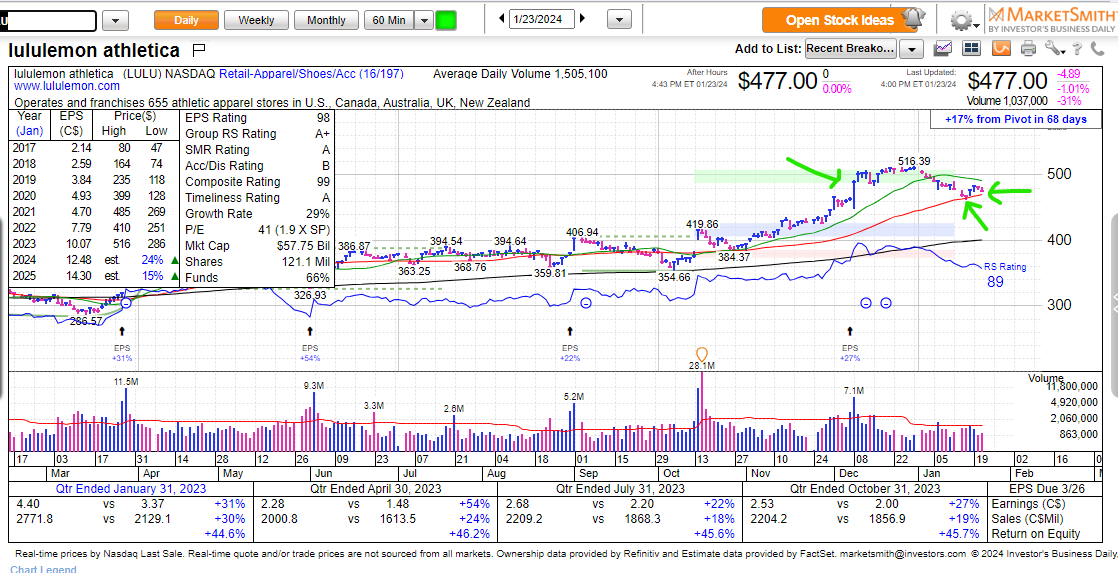Exiting gracefully from a troubled position.
Lululemon Athletica Inc. ($LULU) has been on many watchlists (including on FindLeadingStocks.com) since it had a big gap-up at the end of March 2023. Since then it’s had a few other gap-ups and breakouts. Each time, it seemed to give up most of its gains, only to break out again, reaching new heights. When the November 2023 rally took hold, LULU saw modest but steady growth for weeks and enjoyed a nice 5% breakout in the first week of December. For an A.M.P.D. trader who wanted to take a long position in LULU, the breakout provided a decent entry point with a protective stop of 5-7% below the buy price.
Ups and Downs
Over the next 14 trading days, with some ups and downs, LULU enjoyed a small gain. Starting New Year’s Day, it began giving back those gains, finding no support at the 21-day moving average. Adam Sarhan says, “Be patient with your winners and impatient with your losers.” For an A.M.P.D. trader who bought the breakout, LULU was in the red and beginning to look like a loser, and it wouldn’t be unreasonable to look for an exit.
 Charts & Data Courtesy MarketSmith Inc. Click Here To Join MarketSmith.
Charts & Data Courtesy MarketSmith Inc. Click Here To Join MarketSmith.
Exiting a Position
There are a few different ways to exit a troubled position. A.M.P.D. traders put protective stop orders on their positions when they enter, so that stop serves as the default exit point. Of course, an A.M.P.D. trader doesn’t need to wait for the stop to trigger; they can just sell and take a small loss and preserve the balance of the capital – especially if they would like to invest that money in another opportunity.
Raising Stops
But what if the stock went back up? After all, LULU had demonstrated a recent history of giving up gains and then breaking out again to reach new heights. A third option would be to raise the stop to just below the current price. That way, if the stock goes down the trader is out, but if the stock rebounds, the trader still has a chance to ride it up.
Looking for Support
A fourth option would be to look for the nearest level of support. For LULU, the 50-day moving average was trending just above the pivot point of the big breakout that provided the entry point. A trader could have raised the stop to just below the 50 DMA and waited to see if it found support.
Still in the Game
It turns out, LULU did find support at the 50, and the hypothetical trader who moved their stop to below the 50 DMA would have come within pennies of stopping out, but they would still be in the game. Since then, LULU moved up, but as of today January 23, 2024, it’s coming back down to the 50 – except now, the 50 DMA has risen by about 2%. That means a trader could move their stop up again. If the price fails to find support at the 50, they’ll stop out for a smaller loss, and if the stock rebounds again, they can hang in for a little longer.
Psychological Analysis
The “P” in A.M.P.D. stands for “Psychological Analysis.” Many traders make emotional decisions. An emotional trader might have panicked when LULU started losing ground, and they may have sold it off, taking a small loss but closing the door on potential gains. When an A.M.P.D. trader enters a position, they have already decided how much they are willing to lose when they set their sell stop. This approach means when things get dicey, they can relax, and consider a more graceful exit than panic selling.
Your Risk, Your Reward
How you choose to exit a position is your choice. The A.M.P.D. trading strategy is for self-guided, independent traders who understand there is risk in trading in the market, and who take responsibility for their decisions. This article is for educational purposes and does not constitute financial advice.

